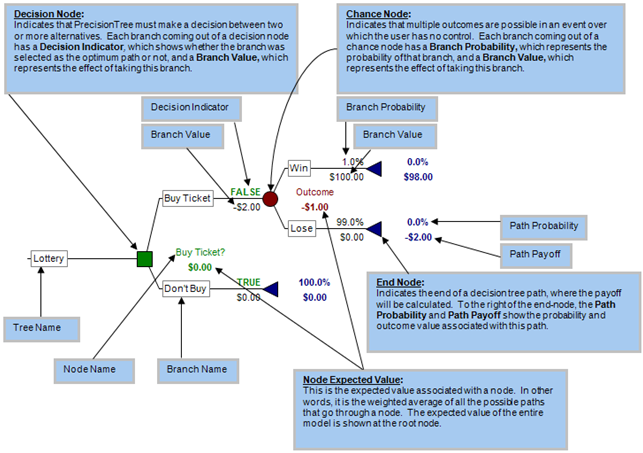Example on precision tree – basic tree terminology|Operation Research
The Westhouser Paper Company in the state of Washington currently has an option to purchase a piece of land with good timber forest on it. It is now May I , and the current price of the land is $2.2 million. Westhouser does not actually need the timber from this land until the beginning of July, but its top executives fear that another company might buy the land between now and the beginning of July. They assess that there is a 5% chance that a competitor will buy the land during May. If this does not occur, they assess that there is a 10% chance that the competitor will buy the land during June. If Westhouser does not take advantage of its current option, it can attempt to buy the land at the beginning of June or the beginning of July, provided that it is still available.
Westhouser’s incentive for delaying the purchase is that its financial experts believe there is a good chance that the price of the land will fall significantly in one or both of the next two months. They assess the possible price decreases and their probabilities in Table. Table shows the probabilities of the possible price decreases during May. Table lists the conditional probabilities of the possible price decreases in June, given the price decrease in May. For example, it indicates that if the price decrease in May is $60,000, then the possible price decreases in June are $0, $30,000, and $60,000 with respective probabilities 0.6, 0.2, and 0.2. If Westhouser purchases the land, it believes that it can gross $3 million. (This does not count the cost of purchasing the land.) But if it does not purchase the land,Westhouser believes that it can make $650,000 from alternative investments. What should the company do?
Table 9.7 Distribution of Price Decrease in May
|
Price Decrease |
Probability |
|
$0 |
0.5 |
|
$60,000 |
0.3 |
|
$120,000 |
0.2 |
Precision Tree Example: Basic Tree Terminology
This example will help you get acquai nted with the basic terminology used to describe a decision tree. Below is a very simple tree called lottery,’ which we have heavily an notated. It contains one decision nodewith two branches, representing a decision of whether or not to buy a $2 lottery ticket. If the”Buy Ticket choiceis made, $2 must be paid, while there is no cost if the-Don’t Buy branch is chosen. If the game is played, there are two possible outcomes. There is a 1% chance of winning a S100 prize, and a 99% chance of not winning anything
Notice that the expeded value of the branch-Buy Ticket” is-Si. Therefore, the smarter decision. in this case, is not to buy the ticket if we are concerned only with expected value. Looking at cells C16 and C22 shows this is the decision Precision Tree arrived at as well. Try changing the values and probabilities of the model to see how these results change.

ASSIGNMENT TASKS
• Examine and summarise the problem in your own words (in word file).
• Develop a solution for the company, and write your recommendation up in the form of a report. formulate it as a spreadsheet (Excel Solver, Decision Tree Analysis for the case question)
ASSESSMENT ELEMENTS
• A description of the problem (in your own words) and solution and recommendations (including any input and output spreadsheets used).
MARKING SCALE
• Presentation and structure.
• Problem description.
• Answer to question.
Report Writing Checklist And Criteria
1. TITLE
– Should give a clear indication of what the report is about
– Should not be too long nor too short
2. TITLE PAGE
– Attractive appearance
– Include title, author(s), date, recipient
3. GENERAL LAYOUT
– Margin widths
– Line spacing
– Font and size
– Format for sectioning, paragraph spacing etc consistent
– Page numbers
– Inclusion of tables and figure with titles for same
– Correct referencing of other work
4. ABSTRACT OR SYNOPSIS AND/OR EXECUTIVE SUMMARY
– In abstract include the problem addressed, the solution approach, the main findings, conclusions, implications, recommendations
– Length – no more than a page
5. STRUCTURE
– Introduction – the problem addressed and why it is important
– Modelling – background, model description, rationale for choice (where appropriate)
– Data description if necessary
– Results
– Conclusions
– Optional – glossary, table of contents, executive summary, appendices
6. CONTENT
– Clarity and directness
– Coherence
– Structure
– Spelling, grammar, sentence and paragraph structure and content
7. MISCELLANEOUS
– The text must tell the story, so don’t rely on graphs, diagrams and numbers to tell the story.
– Don’t include graphs and tables and not refer to them in the body of the report.
– Ensure that there is a flow from one section to the next.
– Support all assertions by facts.
– Do not have too much nor too little white space around a table, figure or graph. Ensure that the format of these elements is the same throughout the document.